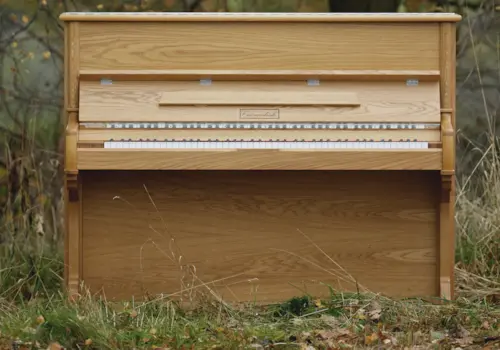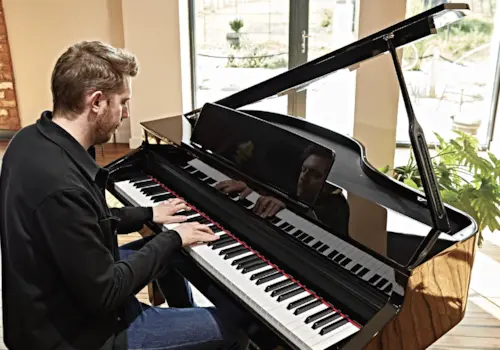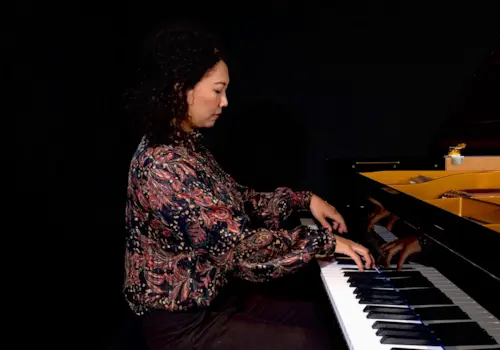This piece is absolutely ideal for any beginner/intermediate pianists! Download the score from our sheet music store below and you are good to go
This lesson is taken from Pianist 104. Get your copy here.
This lesson will improve your:
✔ Balance between the hands
✔ Use of dynamics
✔ Phrasing/melodic shape
Remembered now, if at all, as a pedagogue more than a composer, Le Couppey taught generations of French pianists at the Paris Conservatoire.
Having studied there himself he took up his first post at the prodigious age of 17, was appointed professor of solfège in 1837 and continued to oversee the conservatoire curriculum, with its rigorous insistence on the establishment of
a firm technique, until the year before his death. Among his many pupils were the composer Cécile Chaminade, celebrated soloists of their day such as Léontine Marie Pène, and Marguerite Lartigue, the second cousin of Manuel de Falla, who became in due course the mother of Jacques Ibert.
His own music was accordingly pedagogical by nature – though not too dry, as shown by this waltz-like study. Cast in ternary form and four-bar phrases, it demands a keen sense of phrasing and melodic shape. The suggested tempo of crotchet equals 130-144 beats per minute may seem brisk, but there is scope to broaden the speed at certain points.
Focus on each hand separately
The RH part contains the melody throughout and lies comfortably under the fingers. The two-bar phrases within each longer phrase require minimal hand-position changes.
Try beginning your study of the piece by blocking out these phrases. Thus you would play the C, D, E, F, A, D in bar 1 and the following two Cs in bar 2 together. Then move the hand swiftly into the next position to play all the notes in bars 3 and 4. This exercise will produce some unlikely dissonances and some bars will require more movement than others in order to play all the notes at once. However, the advantage of this technique is that it will establish fingering and note patterns, and it will help you to assimilate convenient hand-position changes.
How do we tackle the rhythmic contour of the melody?
It's mostly shaped by a bar of quavers followed by a minim and a crotchet. For accurate and rhythmically secure playing, try counting in quavers (or semiquavers) as you place each note – particularly the quavers – rhythmically and evenly.
Resist the temptation to rush the final quaver of each bar. The minim-crotchet bars need a precise sense of pulse and a firmer touch on the minim beat. Only add acciaccaturas (ornaments) once the note patterns are secure.
Dynamic shaping will play a crucial role
Begin each phrase quite softly before growing towards the first beat of the fourth bar (bars 4 and 12, for example). Bar 13 might begin mezzo-forte and build to a full forte on the second and third beats of bar 15, ending powerfully on the first beat of bar 16.
Use the slurred phrase marks to help you give a shape to the piece
Bars 1, 3, and 5 (RH) require a clear legato finger technique. Give a little more weight and tone to the top of each mini-phrase (for example, on beat 2 of bars 1 and 3). Then think of the four-bar phrases as single units of expression; where will you decide to invest the most colour and tone? Find time to make the four-bar phrases breathe just as a singer would: try to feel this space for breath in your playing. Short slurs can be articulated with a drop-roll approach. On the first beat of bar 8, for example, try ‘dropping’ the wrist into the F, with the wrist rolling upwards and off the note on the E.
Judicious arm weight lends a rich cantabile sonority to the RH melody
Use a ‘touch and press’ technique for each finger, and play to the bottom of the key, especially at the tops of phrases, where more tone is necessary.
Remember: the LH is the accompaniment in this piece
The dotted minim supplies the bottom of the harmony, and the second and third crotchet beats add a dance-like character (bars1-4, for example).
As with the RH, block out each bar as a chord to begin with, moving through the piece securing fingering and hand positions. Then play the dotted minim alone with a smooth legato between each bar. Then add the second and third beats lightly, while keeping the dotted minim in place.
If you can do this confidently in bars 1-16 and 26-33, creating complete finger legato, you won’t need to rely on the sustaining pedal to join the notes from bar to bar.

When practising with both hands together, you will need to work at balancing the sound. Work at playing the LH softly, even two dynamic markings below that of the right; a pianissimo LH to complement mezzo-piano in the RH, for example.
Where should we add sustaining pedal in this piece?
The sustaining pedal will contribute resonance and colour. However, don’t overdo it! If you have a deft right foot, you may be able to add a little pedal to the first beat of bars 7, 8, 13, 14, 15, 23, 24 and 30-33.
Finishing off
There is a brief, contrasting section in bars 17-25. Shape it with a gentle crescendo to bar 22, taking note of the rinforzando (rf) markings in the LH. Practise finding the shape of each note pattern: emphasizing the first LH quaver, tailing off the phrase ends in bar 18, 20 and 22, and finishing each one with a light staccato crotchet, lifting your finger off the note gracefully at the end of the bar.
You can make a small ritenuto at bar 8, bars 23-25 and the final two bars.
Good luck!









